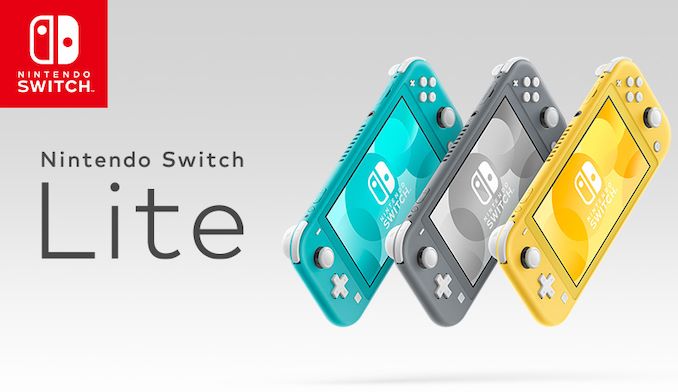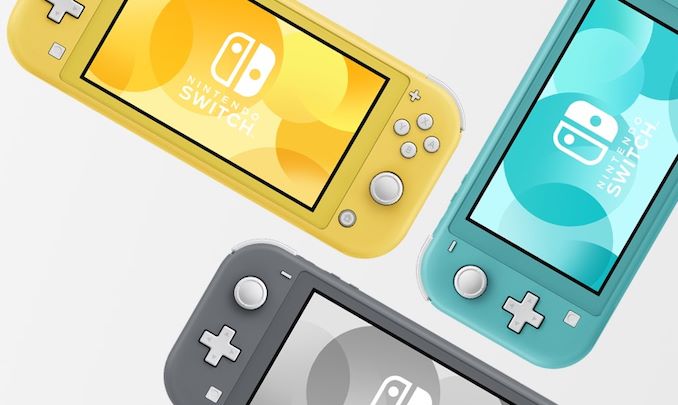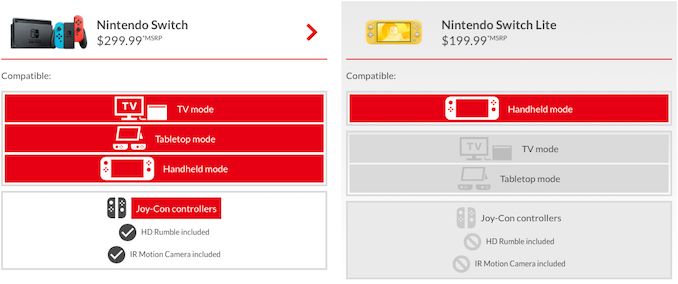Update: Nintendo Reveals Handheld-Only Switch Lite, With a New NVIDIA SoC
by Anton Shilov on July 10, 2019 4:00 PM EST
Nintendo has announced a new version of its Switch game console that only works in handheld mode, yet it is considerably more compact, comes at a lower price point, and works for a longer time on one charge. One of the intrigues about the Switch Lite device is that it might be is powered by a new NVIDIA Tegra SoC, presumably made using a more advanced process technology.
The Nintendo Switch Lite comes with a 5.5-inch LCD featuring a 720p resolution and has built-in controllers that have the same layout as Nintendo’s Joy-Con controllers. The console will support local and online multiplayer modes and will allow up to eight people to play at once anywhere with Wi-Fi. When it comes to style, the gaming device will come in grey, yellow, and turquoise to attract gamers with different tastes. As far as availability is concerned, the Switch Lite will ship on September 20 and will cost $199.99 (down from $299.99 in case of the fully-fledged version).
Since the console is designed for games that support Handheld mode, it cannot connect to TV, work in tabletop mode (because it does not have a kickstand), is not compatible with the Switch dock, does not support HD Rumble as well as IR Motion Camera. The said limitations are fully justified for mobile gaming as the new Switch Lite console is considerably more compact, it weighs 122 grams (0.27 pounds) less, and it works for three to seven hours (up from 2.5 – 6.5 hours in case of the original Switch). The more notable battery life comparison is the 3 hour vs 4 hour gameplay estimate given for Zelda's Breath of the Wild, which is a 33% increase over the original Switch, pointing out to larger efficiency boosts of the hardware.
The longer battery life of the Switch Lite, despite its smaller dimensions (and a lower-capacity battery) may indicate that the SoC inside the Switch Lite – which NVIDIA has confirmed they're powering – is based on an updated Tegra design produced on a more advanced fabrication process. The original Tegra X1 chip was manufactured on TSMC's 20nm process node, which was not exactly the best node when it comes to power efficiency. Recently we've seen evidence of a revision of the X1 with notable changes in the operating voltages of the chip, which point out that this very well might be a die shrink. We believe that it's likely that the new chip is manufactured in a 16nm or 12nm process node.
| Nintendo's Handheld Game Console Specification Comparison | |||||
| Nintendo Switch | Nintendo Switch Lite | ||||
| SoC | NVIDIA Tegra X1 4x ARM Cortex-A57 NVIDIA Maxwell (256 CUDA Cores) |
NVIDIA SoC (12/16nm Tegra X1 Shrink?) |
|||
| Display | 6.2-inch 1280x720p LCD (HDMI: 1080p60) |
5.5-inch 1280x720p LCD | |||
| Size | 102 x 239 x 13.9 mm, 297g (tablet only) 398g w/Joy-Cons |
91.4 x 208 x 13.9 mm, 277 g | |||
| Battery | 4310 mAh (~ 16Whr) 2.5 to 6.5 Hours 3 hours BotW gameplay |
3570 mAh (~13.2Whr) 3 - 7 Hours 4 hours BotW gameplay |
|||
| Storage | 32 GB NAND + microSDXC | 32 GB NAND + microSDXC | |||
| Wireless | 802.11ac Bluetooth 4.1 |
802.11ac Bluetooth 4.1 |
|||
| I/O | Console | USB Type-C | USB-C (power only)- | ||
| Dock | 1x USB 3.0 2x USB 2.0 1x HDMI 1.x 1x USB-C (power only) |
||||
| Launch Date | 03/03/2017 | 09/20/2019 | |||
| Launch Price | $299 | $199 | |||
Neither Nintendo nor NVIDIA have confirmed usage of a new Tegra X1 inside the Switch Lite console.
One interesting note is that while Nintendo hasn't detailed the specifications of the new handheld, they have allowed partner NVIDIA to confirm that they're powering it, leading a good deal of further credit to the theory that the console is being powered by a die shrunk descendant of the Tegra X1.
#WePowerIthttps://t.co/l3AKDR1pD4
— NVIDIA GeForce (@NVIDIAGeForce) July 11, 2019
NVIDIA, of course, was a close partner in developing the original Switch. Along with providing the Tegra X1 SoC inside of it, NVIDIA has supplied a good chunk of the graphics software stack, with Nintendo opting to leverage their experience there. Using another NVIDIA SoC was a foregone conclusion for the Switch Lite, given the compatibility needs, but with secretive Nintendo it's rare to get official confirmation so early on.
Meanwhile, as soon as the Japanese gaming giant launches the new product in September, we will find out for sure what is inside after the console gets teared down.
Related Reading:
- Playing With Power: A Look At Nintendo Switch Power Consumption
- Nintendo Switch Hardware Launch Details - 32GB w/Expandable Storage, 6.2” 720p Screen, 2.5 to 6.5 Hour Battery Life
- Nintendo Announces Switch Portable Gaming Console - Powered by NVIDIA Tegra
Sources: Nintendo, Nintendo.de












51 Comments
View All Comments
Oliseo - Thursday, July 11, 2019 - link
"adults are busy whole day making big money and then go out with beautiful ladies,"Spoken like a child.
eek2121 - Thursday, July 11, 2019 - link
Hey I make big money and go out with beautiful ladies...granted I bring my kids with me, but still...eek2121 - Thursday, July 11, 2019 - link
Then "adults" are doing it wrong. I have 3 kids and none of them have Nintendo Switches.Manch - Thursday, July 11, 2019 - link
Adults also sit on planes, trains, and automobiles on their commutes, business trips, waiting on their beautiful wife to finish the damn shopping. Time to kill...play a video game.Wardrive86 - Thursday, July 11, 2019 - link
I dont know why but I like you....Alistair - Wednesday, July 10, 2019 - link
i meant as an adult with worse vision and a better home theatre, I wouldn't want a portable systemeek2121 - Thursday, July 11, 2019 - link
I wish they'd release a Zen 2/Navi desktop console with even more powerful hardware and make a dramatic return to the traditional console market.SilthDraeth - Thursday, July 11, 2019 - link
Yeah. My eyes still work fairly well, but I have trouble playing Zelda in portable mode. I can do fine with Mario Maker 2, but not Zelda. And definitely not Rocket League.Though, an 8" screen at 1080p and a pro controller split in half, as joycons on the edges. I could work with that.
That's another issue, the joycon button layouts with the joysticks are horrendous for games like rocket league.
jeremyshaw - Wednesday, July 10, 2019 - link
AFAIK, the way the Switch is used, they already have a few things in the SoC that are extraneous to the Switch. Those would probably be the candidates for removal, if it benefits the floorpan. The camera interfaces, the other video outputs (HDMI), PCIe endpoint, the 4 A53 cores (if any actual shipping TX1 has ever had them on die), SATA controller, etc.Does A57 have 16/14/12nm libraries, or is a newer Cortex A7x core possible?
bloodgain - Wednesday, July 10, 2019 - link
I'm not a microarchitecture or semiconductor engineer by any means, but I would assume that they are either using standard cell libraries or ARM produces libraries for their architectures. Either way, there's usually a plan for a die-shrink in the general architecture, even if updates and extensions are planned. Therefore, I would expect most of the standard library to be drop-in compatible if you just wanted to build an existing architecture on a smaller die, and it's just a matter of setting up the fabs to support it (plus testing, of course).I had always assumed this was why Intel adopted the "tick-tock" approach. That gives them 2 years between architecture updates, with only an update that is primarily a fab refit and verification in-between. Of course, these days, that's also often when they increase core counts. It has the bonus benefit of letting them test the new process before building a new architecture on it.